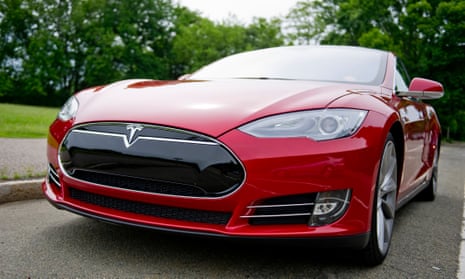Tesla’s latest software update gave its Model S electric car the ability to drive itself with a new AutoPilot mode, but as a collection of owners have found out, two hands on the wheel are most definitely needed at all times.
The new feature, released in beta, uses radar and camera sensors to detect the distance to cars in front to judge speed and brake, while monitoring the white lane lines to guide it round corners. Several other cars from Volvo, Mercedes, Audi and others do similar, but have yet to be able to change lanes like Tesla.
On release, Tesla’s chief executive, Elon Musk, said: “We’re being especially cautious at this early stage, so we’re advising drivers to keep their hands on the wheel just in case. The software is very new.”
The car will chime to remind drivers to put their hands back on the wheel, but that hasn’t stopped people experimenting – with hair-raising effects.
One owner found the car swerved in the direction of a lay-by when the white lines were not painted on both sides of the car, another swerved towards a car in the next lane while emitting warnings about an imminent side impact. The AutoPilot system has also been shown speeding and being pulled over by police.
Tesla is very clear about the fact that the driver is responsible for the car at all times and should be actively in control, despite the AutoPilot system: it will be the driver’s fault, not Tesla’s if the car ends up in a road traffic collision.
The AutoPilot update will be released in Europe and Asia pending regulatory approval, according to Musk.
Beyond the AutoPilot system proving very much a feature in testing, the Tesla Model S has also had reliability issues highlighted in a report by US consumer testing outfit Consumer Reports, which ranked it below average.
A report by the company from its annual reliability survey details a list of consumer complaints from 1,400 people covering failings of major drive components, door handles not allowing entry into the car, wheel misalignments, boot latch problems, inoperable windscreen wipers, squeaks, rattles and other smaller niggles.
Despite the lower than average reliability, the same report found Tesla customers’ satisfaction as a “very high” from 97%. Many of the reliability issues are covered under Tesla’s overall four-year or 50,000 mile warranty and eight-year unlimited mile battery and drive train warranty takes care of most of the major issues at no cost, according to the report.
Many Tesla drivers are early adopters and more accepting of teething problems and the novelty of having a car change with software updates. Such updates have added real value added features including the new AutoPilot mode or Telsa’s “insane” performance mode, as well as fixing bugs and adding small things such as an ever-present smartphone-style battery meter on the central 17-in touchscreen display.

Comments (…)
Sign in or create your Guardian account to join the discussion